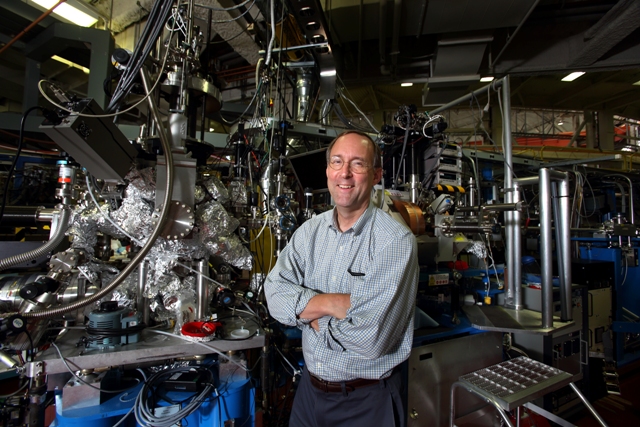A new tri-lab consortium called the Hydrogen Materials – Advanced Research Consortium (HyMARC) has been established to tackle long-standing challenges in the development of solid-state materials for onboard hydrogen storage systems in fuel cell electric vehicles (FCEVs).
 Sandia National Laboratories chemist Mark Allendorf, shown here at Berkeley Lab’s Advanced Light Source facility, is leading the Hydrogen Materials – Advanced Research Consortium (HyMARC) to advance solid-state materials for onboard hydrogen storage. (Photo by Dino Vournas)
Sandia National Laboratories chemist Mark Allendorf, shown here at Berkeley Lab’s Advanced Light Source facility, is leading the Hydrogen Materials – Advanced Research Consortium (HyMARC) to advance solid-state materials for onboard hydrogen storage. (Photo by Dino Vournas)
This consortium will be headed by Sandia National Laboratories, with Lawrence Livermore and Lawrence Berkeley national laboratories also playing a part. The U.S. Department of Energy’s (DOE) Fuel Cell Technologies Office within the Office of Energy Efficiency and Renewable Energy will provide $3 million per annum over a span of three years with the possibility of renewal.
Improved onboard hydrogen storage can aid in developing more economical and reliable hydrogen fuel cell vehicles. In order to address the scientific challenges involved in practical solid-state hydrogen storage, the consortium will exploit the latest developments in material synthesis, high-resolution in situ characterization, and predictive multi-scale modeling.
“Storing hydrogen on board vehicles is a critical enabling technology for creating hydrogen-fueled transportation systems that can reduce oil dependency and mitigate the long-term effects of burning fossil fuels on climate change,” said Mark Allendorf, the consortium’s director and chemist at Sandia National Laboratories.
In the past, numerous materials were developed and characterized for solid-state hydrogen storage, which laid the basis for present-day analysis. This also provided a better insight into the thermodynamics and kinetics that control the physical characteristics of these storage techniques.
“By focusing on the underlying properties and phenomena that limit the performance of storage materials, we will generate much-needed understanding that will accelerate the development of all types of advanced storage materials, including sorbents, metal hydrides and liquid carriers,” said Brandon Wood, who is leading the Lawrence Livermore team.
Sandia National Laboratories are a global pioneer in hydrogen materials science, and were the lead lab in the Metal Hydride Center of Excellence of DOE that ran from 2005 to 2010. The HyMARC program will tap the core capabilities of the collaborative partners, which mainly constitute theory and modeling at Lawrence Livermore, synthetic chemistry at Sandia, and characterization at Berkeley Lab.
Sophisticated experimental equipment from Berkeley Lab’s Advanced Light Source and Molecular Foundry facilities and state-of-the-art supercomputing facilities at Sandia and Lawrence Livermore will be leveraged to develop the hydrogen solid storage technologies.
FCEVs have, in the past five years, made the dramatic transition from concept to reality. Commercial FCEV light-duty vehicles have become a viable option for automakers, and significant investments are increasingly being made to implement hydrogen refueling infrastructure, particularly in the Northeast and Californian markets. At present, hydrogen-refueling infrastructure is being installed for compressed hydrogen refueling, and the FCEVs have been developed for 700-bar compressed hydrogen storage in vehicles.
While compressed hydrogen offers vast possibilities for commercialization, this type of storage technique fails to meet the specified DOE targets for onboard storage of hydrogen, especially in terms of density and cost of volumetric hydrogen energy.
“Hydrogen, as a transportation fuel, has great potential to provide highly efficient power with nearly zero emissions,” said Allendorf. “Storage materials are the limiting factor right now.”
While different kinds of hydrogen storage materials will be considered in the new program, high-density metal hydrides and new sorbents, which are advanced solid-state materials, will be given more precedence. These novel materials could help in meeting DOE targets, and provide hydrogen that has the right energy density and pressure to drive fuel cell vehicles.
However, thermodynamics continues to pose a major complication in the form of the conditions and energy required to emit hydrogen during operation of vehicles. Sorbents can absorb hydrogen in tiny pores, but there is a drawback in that they bind hydrogen too weakly. Metal hydrides store hydrogen in chemical bonds, but they bind the hydrogen too strongly.
Kinetics refers to the speed at which a chemical process takes place. This phenomenon also presents a challenge for high-density metal hydrides. During release and uptake of hydrogen, these materials go through complex reactions that involve transitions between solid, liquid, and gaseous phases. In certain situations, intermediate products are formed during these complex chemical reactions, and these products trap hydrogen.
The strategy of the HyMARC program would be to explore new and unique concepts to overcome these issues. The overall idea is to develop materials that can be suitably controlled to operate as model systems, and also to devise experimental strategies to explore major processes that restrict the performance of storage materials.
“Using these tools, we can study the hydrogen reactions with these materials using state-of-the-art techniques, such as those at Berkeley Lab’s Advanced Light Source and Molecular Foundry, which can provide unprecedented spatial resolution of material composition and character in real time,” said Jeff Urban, Berkeley Lab team lead.
The strategy of the consortium reflects the method that was exemplified in the Materials Genome Initiative (MGI) Strategic Plan to speed up the development of materials. More focus would be given to develop new resources, which can be readily used and accessed by the hydrogen storage community.
“With our extensive knowledge base of hydrogen storage materials and new tools for characterization, modeling and synthesizing materials, many of which were not available even five years ago, our goal is to develop codes, databases, synthetic protocols and characterization tools,” said Allendorf. “These resources will create an entirely new capability that will enable accelerated materials development to achieve thermodynamics and kinetics required to meet DOE targets.”